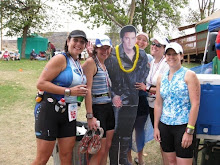
Dr. Lisa Cannada, a runner and orthopedic surgeon, offers advice on knee, foot and ankle pain.
As a new runner, I'm not sure when to run through the pain and when to stop and see a doctor. How can I tell the difference between muscle soreness and an injury?
Just because you feel uncomfortable tightness or some minor pain while running doesn't necessarily indicate you have an injury. You could simply be doing something different--running on a new type of surface or terrain, for example--that works your muscles in a new way. If you only feel pain while you are running, and it goes away within two weeks, it's most likely a strain or soreness.
But there are times when it's crucial to see a doctor, as you could have a variety of more serious conditions. Here are four easy ways to know when you should schedule an appointment:
- If the pain wakes you up at night.
- If you have to alter your gait while running to ease the pain.
- If the pain is constant and occurs during your non-running activities (walking around the office, sitting at your desk, etc.), or if it interferes with your daily life.
- If the pain lasts during running for more than 10 to 14 days.
My knees hurt when I run. What can be causing this and what can I do about it? It seems every female runner I know suffers from knee pain.
The No. 1 cause of knee pain for female runners is anatomy. Most women have a larger Q-angle--the angle between the pelvis and the knee--than men. This increased angle can cause a wide variety of problems, from placing stress on the knee to causing foot pronation (an inward roll of the foot).
The easiest way to minimize knee pain caused by your Q-angle is to strengthen the quadriceps muscles. By strengthening the quads through weight exercises such as leg extensions, you can reduce the stress being placed on the knees.
I recommend strength training three times a week to see improvements. Also, building up your quads is vital if you do a lot of hill running. Running downhill is one of the easiest ways to hurt your knees if you don't have the strength in your quads to support them.
Overuse is another major cause of knee pain. Never increase your mileage by more than 10 percent per day or week, no matter how good you feel. Other common causes of knee pain include being a "weekend warrior" and attempting too much without ample training, bad running form or something as simple as tasks around the house that involve squatting or lifting small children.
After my last marathon, I developed a severe case of iliotibial (IT) band syndrome and spent three months in physical therapy. I'd like to run another marathon, but don't want this to happen again. What can I do about it?
I get so many visits from patients with this problem. IT band syndrome is inflammation in the tendon that runs from the hip to just below the knee. Highly painful around the knee for many runners, the problem most commonly occurs during marathon training.
It happens for a variety reasons, including running constantly on the same angle--like the same side of a slightly canted street during all of your runs. But the biggest cause is increasing your mileage too quickly. Remember the 10 percent rule!
Adding activities like swimming and using an elliptical machine can help keep your endurance up without aggravating the condition. If the pain lasts longer than two weeks, see a doctor. Physical therapy may be recommended.
To prevent this condition, you need to stretch the IT band regularly--not just after you run but at least five days a week. Adding cross-training into your regular schedule can also help. If you don't take preventative action and you let IT band syndrome become severe, you may end up sidelined from running again.
Many people in my running club have problems with plantar fasciitis. What causes this and what can be done to prevent it?
This is the worst! Plantar fasciitis, which can cause a burning or stabbing sensation in the heel, is most common in people with flat feet. Anatomy and wearing the wrong shoes for your foot type are common causes.
Here's a simple way to know if you have an inflammation of the plantar fascia tissue: if the pain is at its worst when you first get up in the morning. Because these tissues in your feet contract as you sleep, the pain can be significant until your feet limber up, and then it will reduce in intensity.
If you have this type of pain for more than two weeks, go see your doctor. They can provide you with an easy cure: a night splint, which stretches the tissues as you sleep.
After a long run, do ice baths help reduce muscle soreness and inflammation? If so, how soon should you take one for it to be effective?
You don't need to take an ice bath unless you are in the top five percent of elite runners, who build up a lot of lactic acid in their muscles. (Most of us never have that much lactic acid in our bodies.) I feel stretching and taking an anti-inflammatory are much better at reducing soreness and inflammation for the average runner. If you are training for a marathon, regular massages can help reduce muscle soreness.





















No comments:
Post a Comment